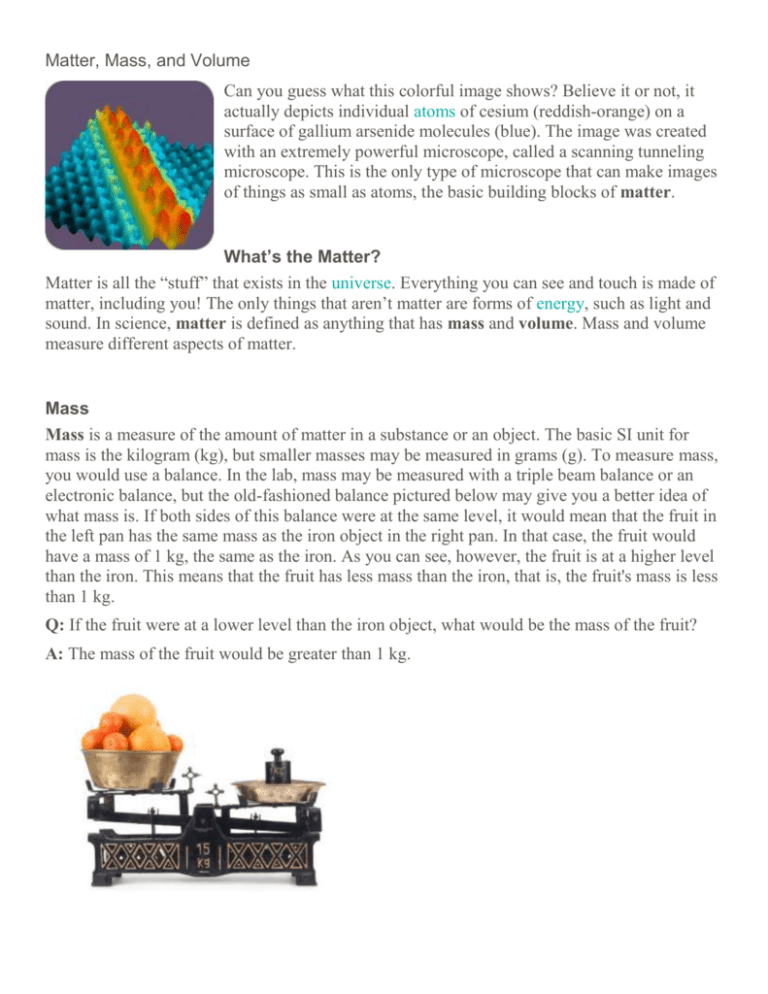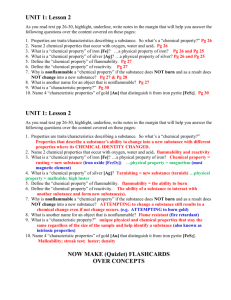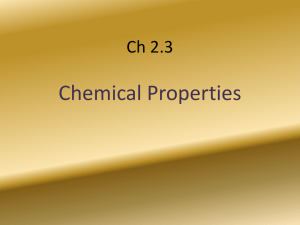Properties of Matter Article
advertisement

Matter, Mass, and Volume Can you guess what this colorful image shows? Believe it or not, it actually depicts individual atoms of cesium (reddish-orange) on a surface of gallium arsenide molecules (blue). The image was created with an extremely powerful microscope, called a scanning tunneling microscope. This is the only type of microscope that can make images of things as small as atoms, the basic building blocks of matter. What’s the Matter? Matter is all the “stuff” that exists in the universe. Everything you can see and touch is made of matter, including you! The only things that aren’t matter are forms of energy, such as light and sound. In science, matter is defined as anything that has mass and volume. Mass and volume measure different aspects of matter. Mass Mass is a measure of the amount of matter in a substance or an object. The basic SI unit for mass is the kilogram (kg), but smaller masses may be measured in grams (g). To measure mass, you would use a balance. In the lab, mass may be measured with a triple beam balance or an electronic balance, but the old-fashioned balance pictured below may give you a better idea of what mass is. If both sides of this balance were at the same level, it would mean that the fruit in the left pan has the same mass as the iron object in the right pan. In that case, the fruit would have a mass of 1 kg, the same as the iron. As you can see, however, the fruit is at a higher level than the iron. This means that the fruit has less mass than the iron, that is, the fruit's mass is less than 1 kg. Q: If the fruit were at a lower level than the iron object, what would be the mass of the fruit? A: The mass of the fruit would be greater than 1 kg. Mass is commonly confused with weight. The two are closely related, but they measure different things. Whereas mass measures the amount of matter in an object, weight measures the force of gravity acting on an object. The force of gravity on an object depends on its mass but also on the strength of gravity. If the strength of gravity is held constant (as it is all over Earth), then an object with a greater mass also has a greater weight. Volume Volume is a measure of the amount of space that a substance or an object takes up. The basic SI unit for volume is the cubic meter (m3), but smaller volumes may be measured in cm3, and liquids may be measured in liters (L) or milliliters (mL). How the volume of matter is measured depends on its state. The volume of a liquid is measured with a measuring container, such as a measuring cup or graduated cylinder. The volume of a gas depends on the volume of its container: gases expand to fill whatever space is available to them. The volume of a regularly shaped solid can be calculated from its dimensions. For example, the volume of a rectangular solid is the product of its length, width, and height. The volume of an irregularly shaped solid can be measured by the displacement method. You can read below how this method works. Q: How could you find the volume of air in an otherwise empty room? A: If the room has a regular shape, you could calculate its volume from its dimensions. For example, the volume of a rectangular room can be calculated with the formula: Volume = length × width × height If the length of the room is 5.0 meters, the width is 3.0 meters, and the height is 2.5 meters, then the volume of the room is: Volume = 5.0 m × 3.0 m × 2.5 m = 37.5 m3 Q: What is the volume of the dinosaur in the diagram above? A: The volume of the water alone is 4.8 mL. The volume of the water and dinosaur together is 5.6 mL. Therefore, the volume of the dinosaur alone is 5.6 mL – 4.8 mL = 0.8 mL. What Are Physical Properties? Physical properties of matter are properties that can be measured or observed without matter changing to an entirely different substance. Physical properties are typically things you can detect with your senses. For example, they may be things that you can see, hear, smell, or feel. Q: What differences between snow and sand can you detect with your senses? A: You can see that snow and sand have a different color. You can also feel that snow is softer than sand. Both color and hardness are physical properties of matter. Additional Physical Properties In addition to these properties, other physical properties of matter include the state of matter. States of matter include liquid, solid, and gaseous states. For example at 20°C, coal exists as a solid and water exists as a liquid. Additional examples of physical properties include: odor boiling point ability to conduct heat ability to conduct electricity ability to dissolve in other substances What Are Chemical Properties? Chemical properties are properties that can be measured or observed only when matter undergoes a change to become an entirely different kind of matter. For example, the ability of iron to rust can only be observed when iron actually rusts. When it does, it combines with oxygen to become a different substance called iron oxide. Iron is very hard and silver in color, whereas iron oxide is flakey and reddish brown. Besides the ability to rust, other chemical properties include reactivity and flammability. Reactivity Reactivity is the ability of matter to combine chemically with other substances. Some kinds of matter are extremely reactive; others are extremely unreactive. For example, potassium is very reactive, even with water. When a pea-sized piece of potassium is added to a small amount of water, it reacts explosively. Flammability Flammability is the ability of matter to burn. When matter burns, it combines with oxygen and changes to different substances. Wood is an example of flammable matter.








